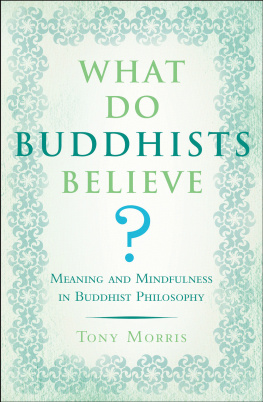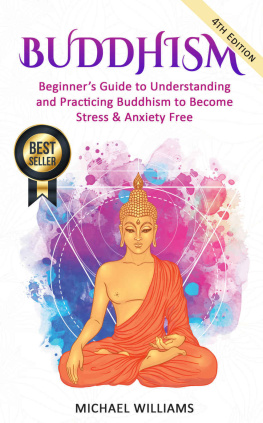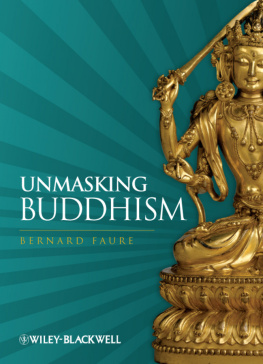Buddhism for Beginners
Plain and Simple Guide to Buddhist Philosophy Including Zen Teachings, Tibetan Buddhism, and Mindfulness Meditation
Judith Yandell
Copyright 2019 Judith Yandell - All rights reserved.
In no way is it legal to reproduce, duplicate, or transmit any part of this document in either electronic means or in printed format. recording of this publication is strictly prohibited and any storage of this document is not allowed unless with written permission from the publisher. all rights reserved. The information provided herein is stated to be truthful and consistent, in that any liability, in terms of inattention or otherwise, by any usage or abuse of any policies, processes, or directions contained within is the solitary and utter responsibility of the recipient reader. under no circumstances will any legal responsibility or blame be held against the publisher for any reparation, damages, or monetary loss due to the information herein, either directly or indirectly. Respective authors own all copyrights not held by the publisher. The information herein is offered for informational purposes solely, and is universal as so. the presentation of the information is without contract or any type of guarantee assurance. The trademarks that are used are without any consent, and the publication of the trademark is without permission or backing by the trademark owner. all trademarks and brands within this book are for clarifying purposes only and are the owned by the owners themselves, not affiliated with this document.
Table Of Contents
Introduction
Welcome to Buddhism for Beginners . You have come to the right place to learn the basics about Buddhism, including basic principles, karma, rebirth, and mindfulness meditation. There are many aspects of Buddhism that revolve around numbers, including 3, 4, and 5. You will gain a basic understanding of the various practices tied to each number. The numbers actually make it a bit easier to remember each principle or practice, such as the 3 universal truths and the 3 higher pieces of training. The final chapter of this book will show you how to incorporate Buddhism into your everyday life, should you decide that this is the philosophy by which you want to live. Yes, we said philosophy because that is what Buddhism is, a philosophy, a way of life.
Many people hear the word, "Buddhism," and they think it is a religion. However, a person of any religion can bring Buddhist principles into their life without giving up their religious beliefs. There is no "God" to worship if you practice Buddhism. There are not Buddhist churches on every other street corner in every town in the Bible belt of the United States. There are no potluck dinners in the fellowship hall after a sermon. Buddhism can be viewed as a religion and under that view, Buddhism is the 4 th largest religion in the world but it is much more than that, its truth goes much deeper than a traditional religion.
Buddhism is a philosophy it is a way of living your life following a path of spiritual development that leads you to the truth of reality. There is no one definition of Buddhism because it is a practicing philosophy that you cannot truly understand until you actually experience it. However, that does not mean that this book is useless; rather, it is a guide to give you a basic understanding of the principles, beliefs, and practices of Buddhism. This will allow you to decide for yourself if Buddhism has a place in your life. Should you choose to follow the path of the Buddha, you can expect Buddhism to change your life.
The word, "budhi," from which the word, "Buddhism," is derived, means "to awaken." That is exactly what Buddhism is an awakening that introduces your mind and spirit to a truthfulness that most people never really experience or even acknowledge. To put it in basic terms, there is one ultimate goal of Buddhism enlightenment. This is a state of mind where you have all of the awareness and wisdom you need to view reality for exactly what it is, allowing you to live a full, happy, and peaceful life in accordance with your enlightenment. This enlightened state of mind is known as Nirvana.
There are varied schools of Buddhism, such as Zen and Tibetan. However, the basic principles and concepts are the same as the goal of enlightenment never changing. Buddhism truly is a way of life, rather than a traditional religion. There is a long history behind Buddhism, one that tells the story of the founder of this philosophical way of life. Let's begin Buddhism for Beginners by learning about the history behind this enlightened way of living.
Chapter 1: Origins of Buddhism
As with any religion or philosophical teachings, there is always a starting point, a place where the idea behind the religion or the philosophy took hold, like a seed of a tree sprouting and spreading its roots. Understanding the history behind any particular religion or philosophy is the first step towards understanding the beliefs as a whole. You need to know where the beliefs came from and why in order to fully grasp their truth. Before you can even begin to learn the basics about Buddhism, you must learn the history of this great philosophy. Buddhism was not the result of a combined meeting of minds; rather, it was the result of one man's persistent desire to know the truth.
The Story of Siddhartha Gautama
Siddhartha Gautama was born below the Himalayan foothills in approximately 567 B.C.E. into the clan of Shakya, of which his father was chief. The story says that when Siddhartha Gautama was about 12 years old, the brahmins members of the highest Hindu class, who were priests, teachers, and overall protectors of sacred learning gave the prophecy that Siddhartha Gautama would either be a collective ruler or a celebrated holy man. His father kept him confined with the walls of the palace, where Siddhartha Gautama grew up in luxury. He was kept within the walls of the castle to prevent him from becoming a holy man, also known as an ascetic. An ascetic one who practices self-denial to the extreme, leading a simple life while pursuing spiritual goals. This was not the life his father wanted for him, so he shielded his son from the outside world in hopes that Siddhartha Gautama would grow to be a great ruler.
Siddhartha Gautama was trained to swim and wrestle, as well as training in archery and as a swordsman. Siddhartha Gautama eventually married Yaodhar, his cousin, and they soon had a child, a son named Rhula. It was not uncommon for royal families to marry among themselves because no other people were considered to be their equal; they wanted to keep the royal line pure. Siddhartha Gautama's life was full and rich in today's world, he would be one of those people who simply has everything wealth, luxury, a wife, and a child. With all of this happiness and luxury, what possible reason was there for Siddhartha Gautama to feel unsatisfied?
There was a longing inside of Siddhartha Gautama, a need to know more, a feeling of dissatisfaction with the life surrounding him. This longing led him to explore the world outside of the palace walls. In Kapilavastu, he came across 3 things: an old man, a sick man, and a dead body being taken to the grounds for burning. Siddhartha Gautama had never seen such things before during his sheltered existence he was not prepared; he did not understand what was happening before him. His chariot driver simplified it for him every living being gets older, faces sickness, and eventually dies. This information caused great worry and uneasiness inside of Siddhartha Gautama.
On the way back to the palace, he saw an ascetic dressed in a robe and carrying a bowl of a sadhu, or a holy man. It was then that Siddhartha Gautama vowed to leave his life of luxury in the palace, as well as his wife and child, to find the solution to all of the suffering in the world. He never woke his wife and son up to bid them goodbye; instead, he said his goodbyes under the cover of darkness, and he disappeared into the woods. There, Siddhartha Gautama used his sword to cut his long hair and donned a simple robe a robe of an ascetic.










